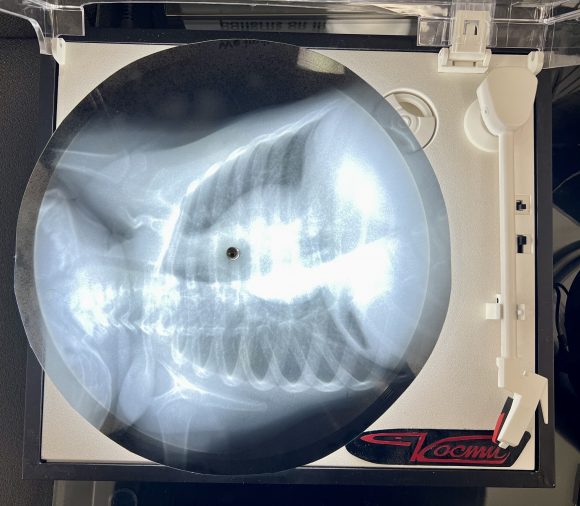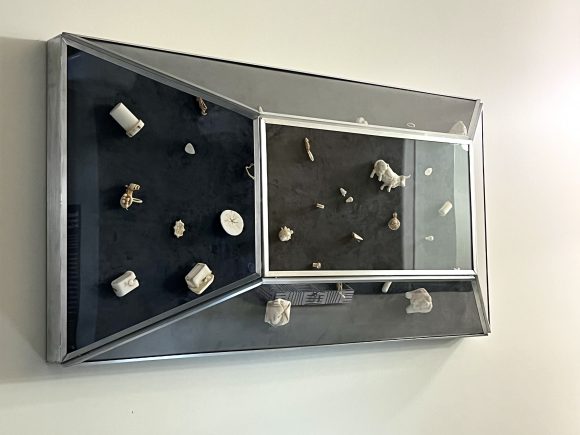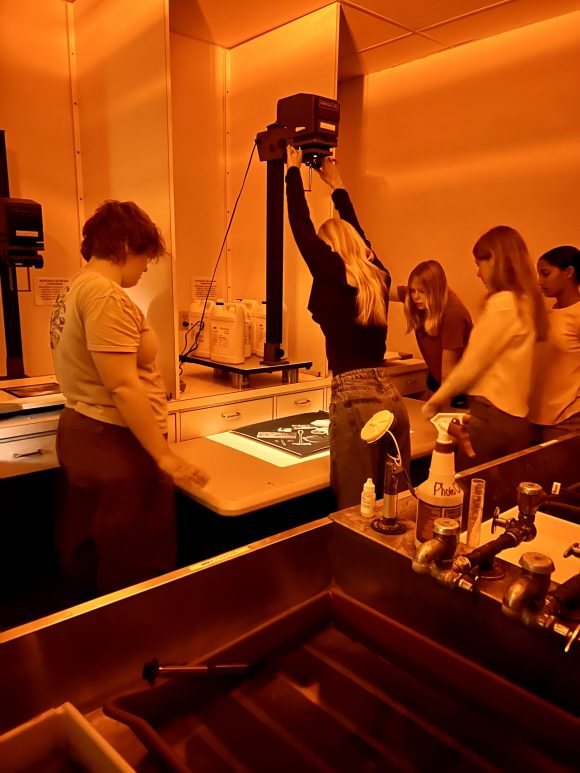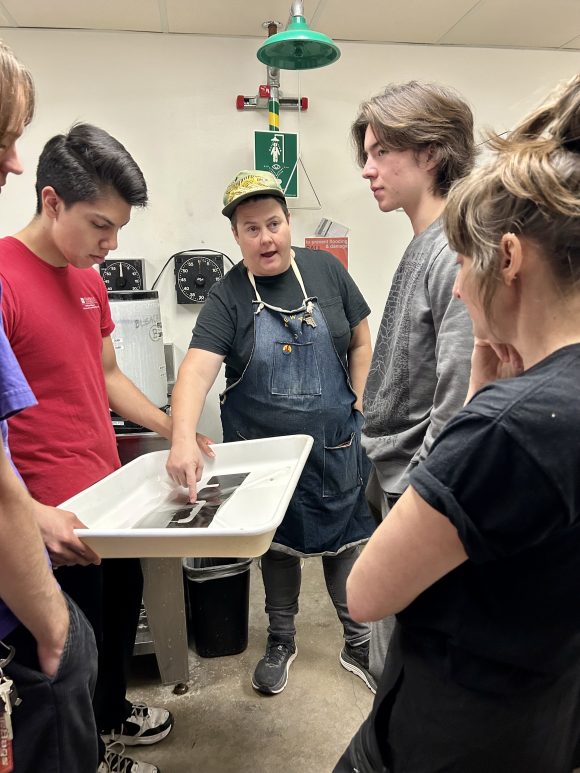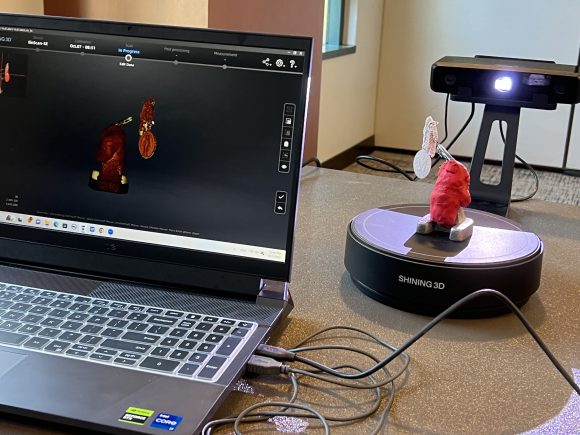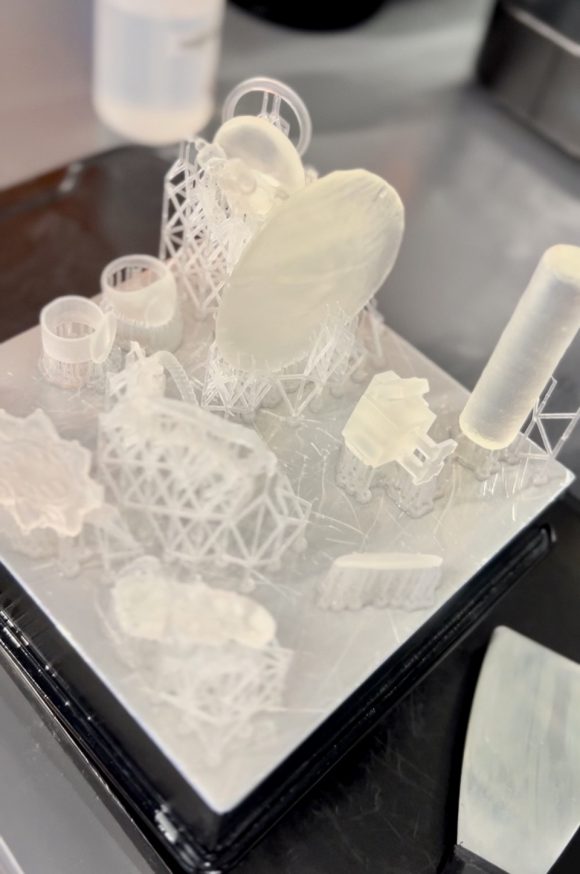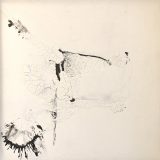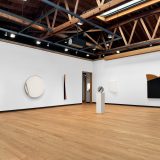Bound in Bone A New Student-Generated Exhibition in Roosevelt Hall
January 8, 2024
In response to Wilkinson College’s 2023 Engaging the World Initiative, Leading the Conversation on Health Equity, the Escalette Collection of Art partnered Wilkinson and Crean College students with LA-based artist Jenny Yurshansky to create an experiential display in Roosevelt Hall titled Bound in Bone. The exhibition will be on display until November, 2024. Roosevelt Hall is open to the public from 7am – 7pm Monday-Friday. Tours available by appointment on weekend. Contact artcollections@chapman.edu
Creating Bound in Bone was a semester-long project involving multiple classes and student workshops. Unlike other Escalette Collection exhibitions, which typically draw from existing work in the permanent collection, all of the objects in Bound in Bone were made for the show. Fiona Shen’s FFC class, The Escalette: An Experiential Journey, spearheaded the effort by helping create the objects and curating the final display. Students from Julie Shafer’s first-year Photographic Imaging course made the photographic elements of the exhibition.
The collaborative nature of this exhibition allowed students to reflect on health and wellness through a community, processed-based perspective. It also enabled them to weave their own stories into the final display. For Laura Morey (Strategic & Corporate Communication ‘27), this was her favorite part of the exhibition: “I loved creating this exhibition… because everyone’s story is being told in some way. Everyone was included in the project and got to put their own spin on the exhibition. I learned a lot about my classmates’ backgrounds, and I think that it is really important to hear everyone’s stories.” The Escalette Collection plans to accession some of these student-created artworks into the permanent collection after the conclusion of the exhibition.
“This exhibit holds special meaning compared to other art on campus because it was created by students… I feel truly honored that I was able to be a part of something so unique here on campus.” – Alana Sharp (Creative Writing ‘27)
Exhibition Background
Bound in Bone relates students’ memories of family resilience, recovery from hardship or trauma, and health and well-being through objects. This project allowed students to consider the intergenerational aspects of health and wellness, both individually and in community with one another. Its components play with the ideas of what is visible, what is remembered, what is shared, and what is felt. It reflects on how we carry our stories in our bodies and how they bind us to our past and each other.
Jenny Yurshansky is an interdisciplinary artist whose family story often serves as the foundation of her practice. Yurshansky was born stateless in Rome while her parents, Jewish refugees from the Soviet Union, navigated seeking asylum in the United States. Displacement, migration, and intergenerational resilience and trauma are themes that run through her work. While her family history serves as a jumping-off point, her projects are decidedly outward-facing, centered on community engagement and building frameworks for others to share their experiences.
“The most meaningful to me is knowing that we all carry this experience forward, and it will be part of the future discussions we will continue to have. My work is iterative for this reason, generative and expansive in a way that includes the voices and experiences of participants and visitors so that our stories go beyond the space of the exhibition and their impact is carried out into those we interact with in our lives… My hope is that we all find ourselves in constructive interference as we overlap rather than collide, centering our care for one another as we gently intersect.” – Jenny Yurshansky
Bound in Bone is based on one of Yurshansky’s ongoing projects titled Rinsing the Bones, a Russian expression associated with gossip but with origins in an ancient Slavic burial ritual that involved physically cleaning the remains of a deceased loved one while recounting their life. This ritual was believed to free the spirit so it may eternally rest. By unearthing the memories, stories, and objects associated with their family stories, the participants who contributed to Rinsing the Bones found release in sharing their stories.
Exhibition Process and Components
Bound in Bone began with a workshop where Wilkinson and Crean College students brought small family heirlooms or keepsakes that held a meaningful story. Each student was interviewed by Yurshansky about the object and asked to reflect on how their story has shaped their well-being today. These interviews were recorded and shared as X-ray records that visitors can play on a modified illuminated record player. The X-ray records create a ghostly echo of the interview audio. Yurshansky describes this phenomenon as “Generation Loss,” a double reference to the degradation that inherently occurs each time the record is played and the losses that are felt in a family with each new generation. The X-ray records juxtapose the physical and the emotional, literally inscribing family stories on images from deep within the human body.
While the students were being interviewed, the objects they brought were 3D scanned and transformed in a few different ways. First, they were 3D printed with white resin and treated to look like bones. These objects are displayed in a metal frame designed to look like a reliquary (a container for displaying holy relics). The reliquary suggests that we carry the stories of our ancestors “in our bones” in the same way that objects hold memory and significance.
A second batch of 3D prints was made in clear resin and displayed in a metal vitrine. The vitrine is installed in a spotlit, windowed alcove of the first-floor conference room so that the objects cast a shadow on the glass, visible from the conference room. The vitrine visually disrupts the viewer’s idea of the “real” object, contrasting the physical object with its shadow. Like the reliquary, this juxtaposition demonstrates that while family experiences and stories can take on a life of their own, they are tied to the physical – they are carried in objects and the bodies of those safeguarding them. The vitrine is also designed to reference a museological display where objects are organized by size and cataloged by type. The ghostly shadows in the conference room contrast with the scientific arrangement in the hallway in a way that complicates the archival value we assign objects. Without preserving the original stories associated with the objects, they become shadowy mirrors, taking on the values and ideas of the viewers who seek to assign meaning to them.
Lastly, the students’ keepsakes became the subjects of photograms (a type of photography where objects are placed on light-sensitive paper and exposed to light) crafted by first-year art photography students to look like X-rays. Making these photograms involved a technically tricky double exposure to create the illusion of the objects hidden within a suitcase. The suitcase seen in these images was used by Yurshansky’s grandmother to carry all the belongings she brought with her when seeking asylum. This symbol of migration, trauma, and resilience is transformed to hold the ghostly outlines of the students’ objects.
- First-year photography students practicing printing photograms.
- First-year photography students testing the exposure of the photogram prints.
Through this exhibition, the students from Professor Shen and Shafer’s classes were introduced to Chapman University’s Design/Create/Innovate Lab. They learned the fundamentals of 3D printing and helped sand and process the 3D prints so they could be incorporated into their displays.
- One of the students’ objects being 3D scanned in preparation of 3D printing.
- Objects printed in clear resin. Students assisted with the cleaning and processing of these objects so they could be displayed in the vitrine.
Exhibition Curation
While the creation of the x-ray records, reliquary, and vitrine was underway, students from Fiona Shen’s FFC The Escalette: An Experiential Journey worked with Yurshansky to curate the exhibition space. They created the exhibition title, introduction text, and elevator graphic. Yurshansky also worked with the students to bring textiles with Soviet-era sewing patterns embroidered by past Rinsing the Bones participants and a shroud-like fabric that visitors can use to create their own frottage or rubbing of a special object. It was essential to both the students and the artist that the exhibition have interactive components that allow viewers to participate in the continued making of the space. Like many of her classmates, Sadie Henderson (English ‘27) enjoyed learning about the exhibition process through the eyes of a working artist: “One of the things I found most interesting to learn about and experience was what it was like to work with a professional artist. It was interesting to experience the dynamic of both creating art that is meaningful to you, while also representing [the artist’s] vision… It felt like a perfect blend of representing Jenny Yurshansky and also representing the class.”

Cloths with Soviet-Era sewing patterns embroidered by participants of Bound in Bone and Rinsing the Bones.
Support for this project was generously provided by the Phyllis and Ross Escalette Permanent Art Collection Endowment, Wilkinson College of Arts, Humanities, and Social Sciences, and Crean College of Health and Behavioral Sciences.
We invite you to explore all the works in the Escalette Collection by visiting our eMuseum.
Wilkinson College of Arts, Humanities, and Social Sciences is the proud home of the Phyllis and Ross Escalette Permanent Collection of Art. The Escalette Collection exists to inspire critical thinking, foster interdisciplinary discovery, and strengthen bonds with the community. Beyond its role in curating art in public spaces, the Escalette is a learning laboratory that offers diverse opportunities for student and engagement and research, and involvement with the wider community. The collection is free and open to the public to view.


